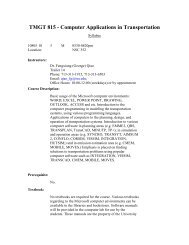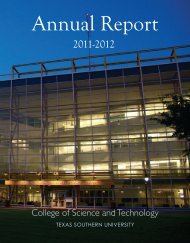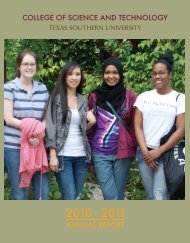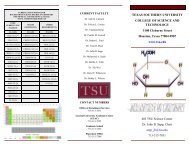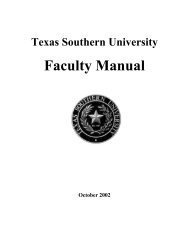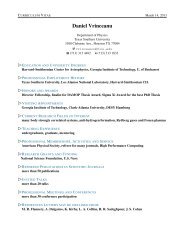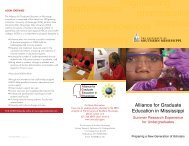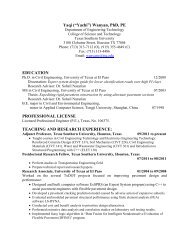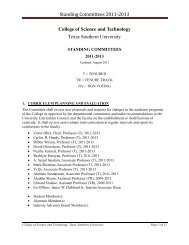TEXAS SOUTHERN UNIVERSITY - COST Home Page - Texas ...
TEXAS SOUTHERN UNIVERSITY - COST Home Page - Texas ...
TEXAS SOUTHERN UNIVERSITY - COST Home Page - Texas ...
You also want an ePaper? Increase the reach of your titles
YUMPU automatically turns print PDFs into web optimized ePapers that Google loves.
<strong>Texas</strong> Southern University<br />
Houston, <strong>Texas</strong><br />
Department of Mathematics<br />
Phone: 713-313-7002<br />
MATH. 241 -- Calculus I (4 Hours)<br />
COURSE SYLLABUS<br />
Spring 2011<br />
COURSE DESCRIPTION: This course is the first semester calculus course of a three<br />
semester calculus sequence. This course reviews basic topics in functions of real variables such as<br />
algebraic, logarithmic and exponential, as well as trigonometric functions and their graphs. The<br />
concepts of limits, continuity and derivatives of these functions are discussed. Applications of the<br />
derivative are also explored.<br />
PREREQUISITE: MATH. 133 and 134 or MATH 136.<br />
REQUIRED TEXTBOOK:<br />
CALCULUS: EARLY TRANSCENDENTALS by William Briggs and Lyle Cochran.<br />
(Addison Wesley, 2011).<br />
COURSE OBJECTIVES: The student is expected to:<br />
1. Recall how to evaluate a function, especially the difference quotient.<br />
2. Learn the definition of the limit and the derivative of a function<br />
3. Evaluate the derivative of a function<br />
4. learn to apply the derivative to curve sketching as well as other applications in<br />
science and engineering.<br />
Class Time: MTWF 11:00 - 11:50AM<br />
Location: SB 148 on MWF and SB105 on T<br />
Instructor: Dr. Victor Obot<br />
Office:<br />
SB 120<br />
Phone:<br />
713-313-7118<br />
Email:<br />
obot_vd@tsu.edu<br />
Office Hours:<br />
MWF 9:00 -10:30AM;<br />
MW 1:00 – 2:00PM<br />
T (2:00 – 4:00PM) Math learning Center RM 102D
REQUIREMENTS: The student is expected to attend class regularly and to turn in<br />
assignments on time at the beginning of the class period. <strong>Home</strong>work assignments more<br />
than one class period late will not be accepted. It is imperative that each student begin<br />
this course with a complete understanding of algebra, trigonometry. There will be no time<br />
to relearn this material during the semester. In particular, be familiar with algebraic,<br />
exponential , logarithmic and trigonometric functions.<br />
A graphics calculator, such as the TI-83, is a requirement. There will be a short discussion<br />
in class on the use of the calculator for graphing functions as well as other uses.<br />
You should also obtain a MyMathLab code. This will aid you in acquiring additional<br />
help in understanding the material discussed in class. The MyMathLab course ID is<br />
obot46615.<br />
You should become familiar with the use of Blackboard.<br />
GRADING: There will be four examinations during the semester and a final examination<br />
at the end of the semester. <strong>Home</strong>work problems will be assigned in class. These problems<br />
will include solving application problems in such fields as physics, chemistry, medicine<br />
and economics. There will be unannounced quizzes. The quizzes will be based on the<br />
home work assignments. You should do the homework assignments in a notebook. When<br />
the quiz is given, you will be informed which homework problem the particular quiz comes<br />
from. If you did the homework problem, you may open your notebook and simply copy<br />
down the problem in question. The five lowest quiz grades will be dropped. There will be<br />
no make- up quizzes. The lowest test grade will be dropped. In general, there will be no<br />
make –up tests, however, a student who misses an examination for good reason may take a<br />
more difficult make-up test.<br />
The exam grades and a grade based on the homework/quizzes are used to determine a<br />
student’s final grade. Each examination counts as 20% of the final grade and the<br />
homework assignments as another 20% . The final exam counts as 20% . Letter grades<br />
will be assigned as follows:<br />
A = 90% or above B = 80 – 89% C = 65 – 79%<br />
2<br />
D = 50 – 64% F < 50%<br />
IMPORTANT INFORMATION: The grade of I is given only when a student’s work is<br />
satisfactory in quality, but due to circumstances beyond his or her control, the student was<br />
unable to complete a small portion of required work. A grade of I is not given in place of<br />
a failing grade; please do not ask for an I in place of an F or any other grade.<br />
Requests for a change of grade after the final grade has been recorded will be honored only<br />
if, due to an error on my part, the wrong grade was submitted.<br />
Dropping a Course: Non attendance is not the same as dropping a course. To drop a<br />
course, you must go to the Registrar’s office and fill out the appropriate forms before the<br />
dateline. The grade of W is given for a course officially dropped by the deadline for<br />
dropping a course. This grade is assigned by the Registrar. I cannot submit a W for a<br />
student who has not dropped the course.
3<br />
Academic Dishonesty: It is not expected. The maximum penalty for cheating is expulsion from<br />
the university. At a minimum, you should expect a zero grade on the particular activity involved.<br />
This applies to the person doing the cheating and the person abating the cheating. The best<br />
solution is not to talk during examinations or spend time looking at someone else paper.<br />
American with Disabilities Act:<br />
<strong>Texas</strong> Southern University maintains a policy for students with disabilities in accordance<br />
with the American with Disabilities Act of 1990, and Section 504 of the Rehabilitation Act<br />
of 1973. Under these federal guidelines, the University is obligated to:<br />
1. Protect the civil rights of students with disabilities.<br />
2. Protect the confidentiality and privacy of students with disabilities.<br />
3. Provide reasonable accommodations and services to students with known<br />
disabilities, who are qualified to meet the requirements of the academic program,<br />
apart from the handicapping condition.<br />
The burden of proof is on the student to demonstrate the need for requested<br />
accommodations. If you feel you are qualified to receive services, please contact the<br />
Office of Disabled Students Services at 713-313-4210 or visit the office in the Fairchild<br />
Building, Room 147 between the hours of 8 am and 5 pm, Monday through Friday.<br />
Cell Phones: They are to be turned off or put in vibrate mode during class. Under no<br />
circumstances are they to be answered. If you find it necessary to leave class in order to answer<br />
your cell phone, please pack your belongings with you so that you can proceed immediately to<br />
take care of the emergency. Do not return to class. During tests, phones are to be turned off<br />
and put away. No phones are to be on your desk or on your immediate possession during a test. I<br />
am not interested in semantics. If a cell phone is on your desk, in your hands, etc. during a<br />
test, you will be accused of text messaging, thus cheating on the test. During a test, you<br />
may not leave the room to make a phone call or answer your cell phone.<br />
HELPFUL HINTS: The following are some suggestions to enhance your chances of<br />
completing the course successfully.<br />
1. Attend classes regularly, be on time, pay attention in class and ask questions when<br />
you do not understand something.<br />
2. Take good notes in class and revise them after class if necessary.<br />
3. Plan to spend time on the class assignments, at least two to three hours for each<br />
hour of class time; seek additional help if you have any difficulties with an<br />
assignment, you are always welcome in my office; study in groups if possible.<br />
4. Establish a study routine; find a comfortable and quiet location to work and do<br />
not fall behind.<br />
5. Read both the class notes and the textbook before starting the assignments; study<br />
the examples carefully, always read with a pencil and paper at hand; you learn<br />
mathematics by doing mathematics!<br />
6. Review regularly; do not wait until the last minute to prepare for an examination.
Mathematics 241: Calculus and Analytic Geometry I<br />
Course Outline<br />
Topic 1 REVIEW OF REAL FUCTIONS OF REAL VARIABLES ( 2 WEEKS)<br />
4<br />
1.1 Functions and their graphs. Domain and range of a function<br />
1.2 Operations on functions: addition, subtraction, multiplication, division and<br />
composition.<br />
1.3 Inverse, exponential, and logarithmic functions<br />
1.4 Trigonometric functions<br />
Test 1<br />
Topic 2 LIMITS OF A FUNCTION ( 3 WEEKS)<br />
2.1 Definition of limits<br />
2.2 Techniques for computing limits<br />
2.3 Infinite limits<br />
2.4 Limits at infinity<br />
2.5 Continuity<br />
Test 2<br />
Topic 3 DERIVATIVES I (3 WEEKS)<br />
3.1 Definitions<br />
3.2 Rules of differentiation<br />
3.3 Derivatives as rates of change<br />
3.4 Derivatives of trigonometric functions<br />
Test 3<br />
Topic 4 DERIVATIVES II (3 WEEKS)<br />
4.1 The Chain Rule<br />
4.2 Implicit differentiation<br />
4.3 Derivatives of logarithmic and exponential functions<br />
4.4 Derivatives of inverse trigonometric functions<br />
Test 4
Topic 5. APPLICATIONS (3 WEEKS)<br />
5.1 Related rates<br />
5.2 Maxima and Minima<br />
5.3 Graphing functions<br />
5.4 Optimization problems<br />
5.5 Limits revisited ----- L’Hopital’s Rule<br />
FINAL EXAM.<br />
5



